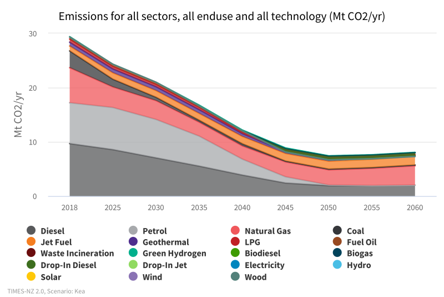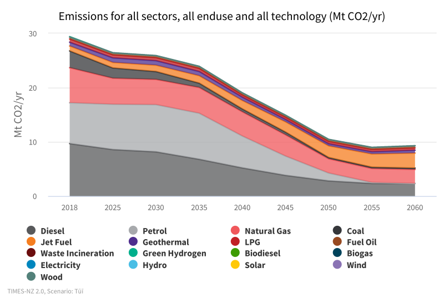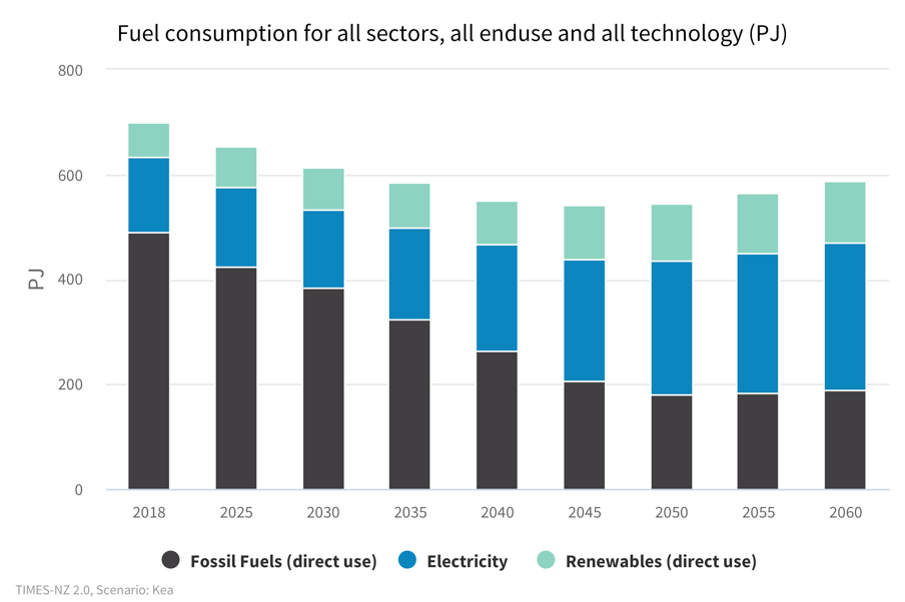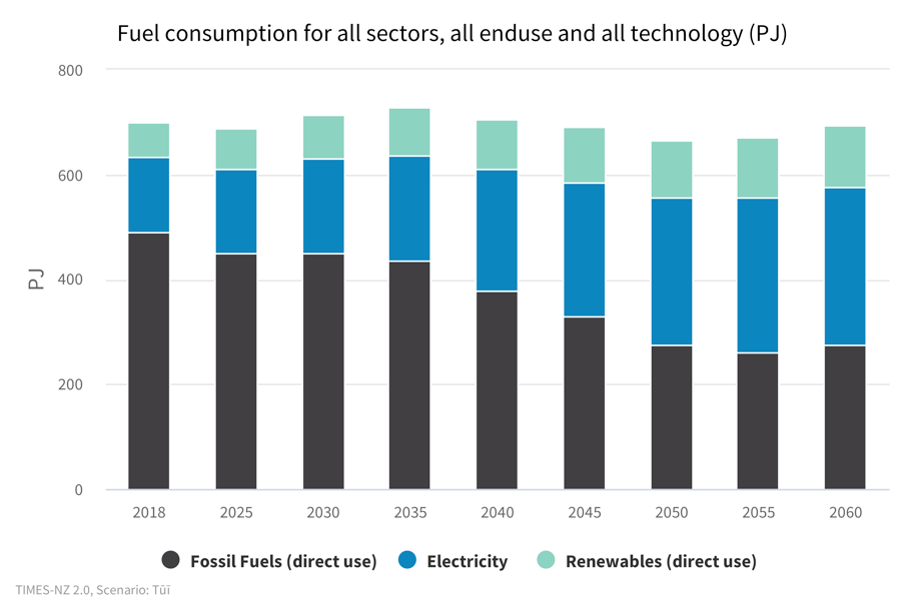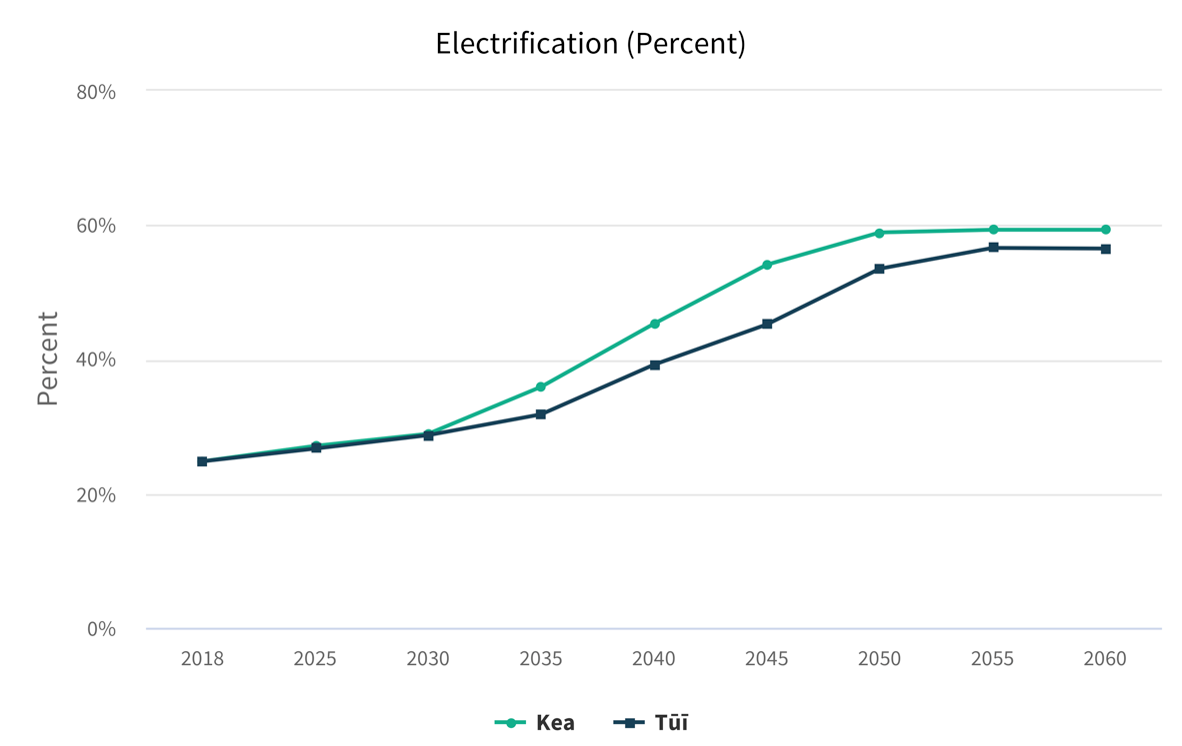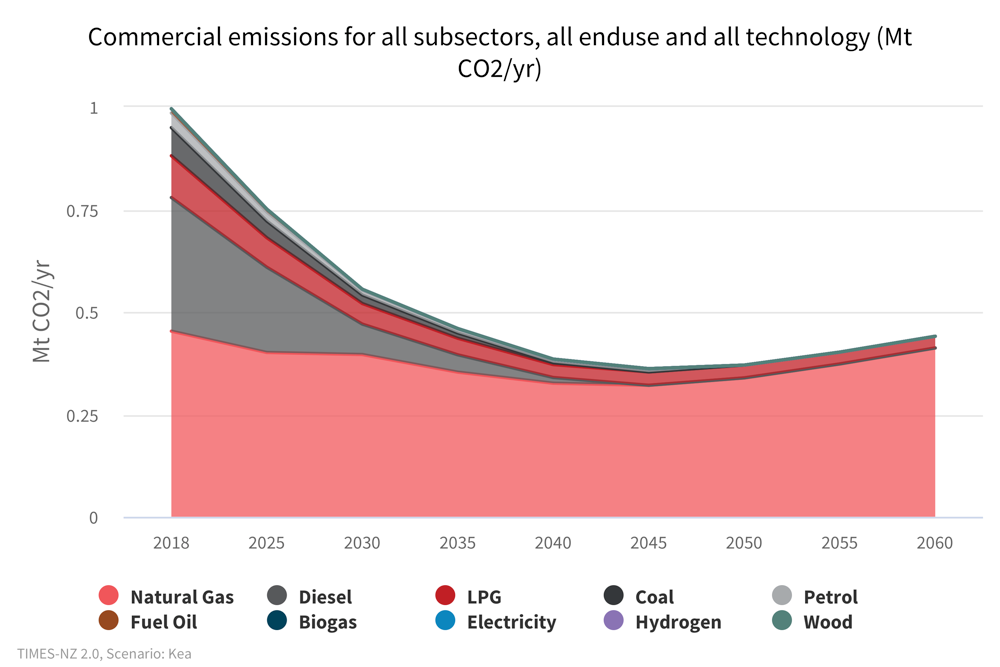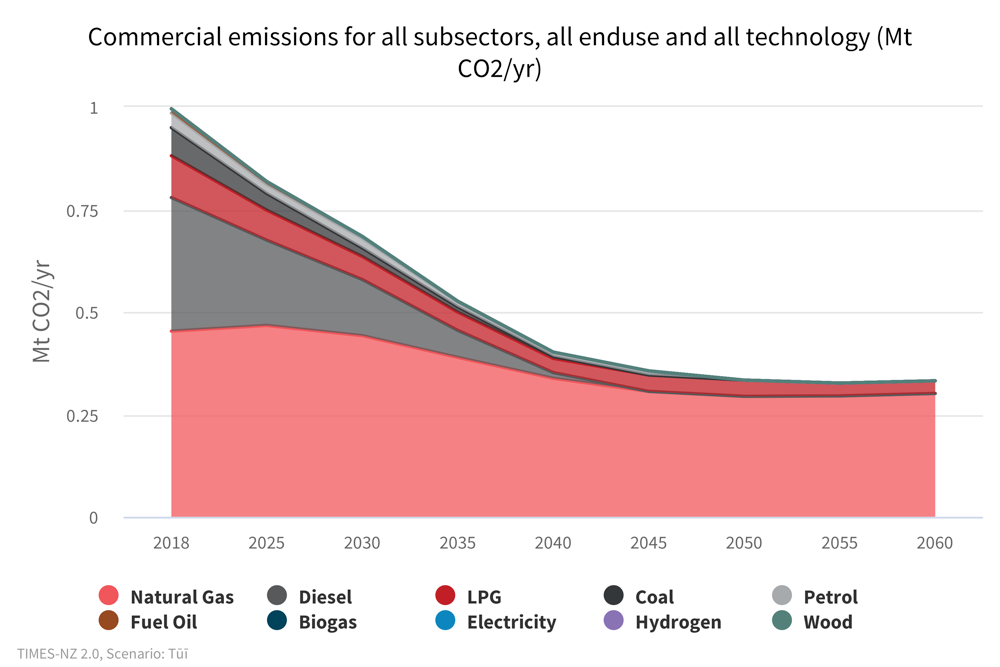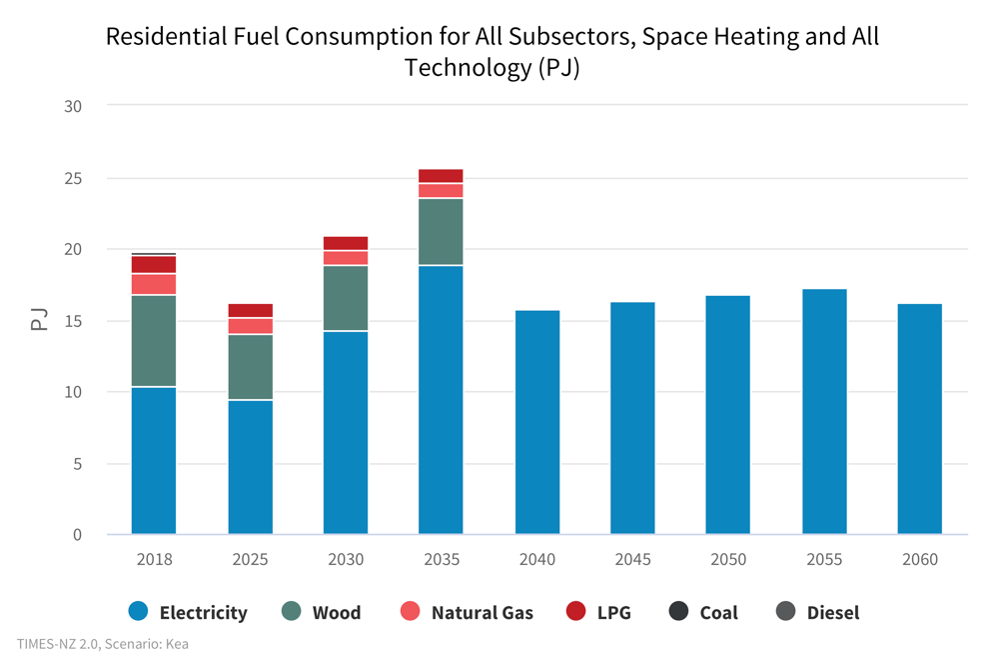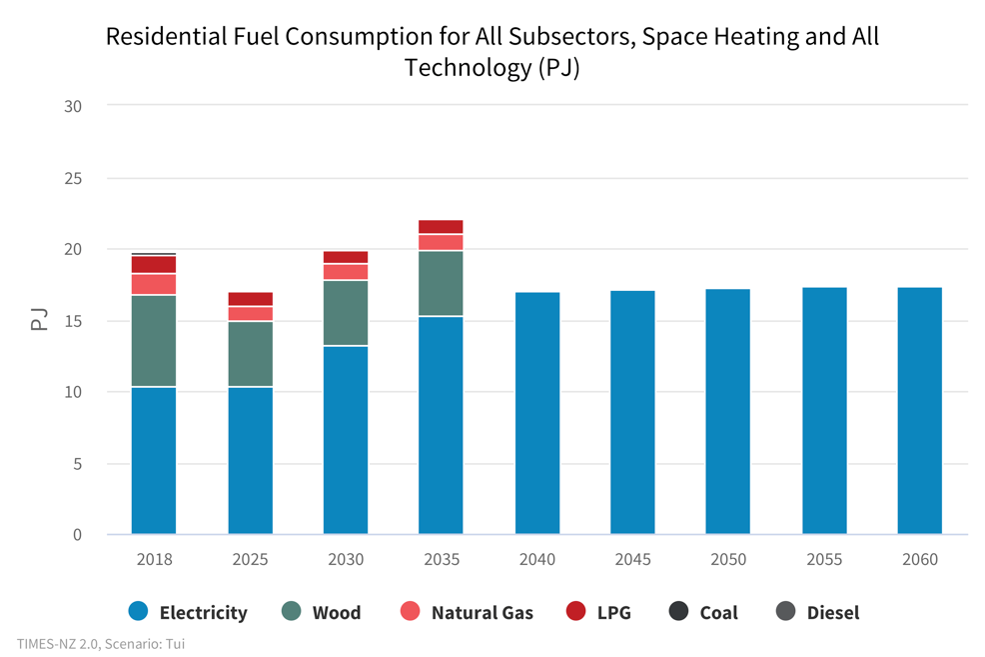Sectors
There are six sectors explored in TIMES-NZ 2.0
Electricity
Transport
Agriculture
Industrial
Commercial
Residential
All Sectors
All Sectors – What might our energy sector carbon emission footprint look like?
Kea
Tūī
Both scenarios show strong reductions in energy emissions. Tūī shows a decline to 10 Mt CO2-e/year in 2050 while Kea is even lower at 6.5 Mt CO2-e/year in 2050. Moreover, Kea’s more rapid emissions decrease means that the model output indicates cumulative emissions through to 2050 are nearly 25% lower in Kea than under Tūī.
The most striking difference between Kea and Tūī in this regard is the presence of drop-in diesel and jet fuel, which is lacking in Tūī. This, coupled with a general decrease in domestic air travel, has the effect of significantly reducing the total and percentage amount of jet fuel emissions in Kea compared with Tūī.
Kea fully eliminates petrol as a source of emissions between 2050 and 2055, with Tūī seeing the same between 2055 and 2060. This is due to electrification of the vehicle fleet. Note that diesel remains as a significant contributor under both scenarios, in large part due to an inadequate transition to electrification or hydrogen for heavy machinery.
All sectors – What and how much energy might we consume?
Kea
Tūī
Kea and Tūī both show a gradual increase in electrification, with a corresponding drop in direct fossil fuel consumption. Transport is the most prominent driver here, with air travel and heavy vehicles/machinery accounting for a significant portion of the remaining reliance on fossil fuels.
Direct use of renewables plays a similar, although slightly more prominent role in Kea.
Overall consumption declines steadily in Kea until 2050, when electrification sees an increase of a level that has the effect of increasing overall consumption. This is the driver of increases seen at both 2055 and 2060.
Much the same can be seen in Tūī, except with a higher base level as a result of a more prominent reliance on direct use of fossil fuels. A lack of technological development is in large part responsible for this.
Fossil fuel consumption sits at 181PJ in 2055 under Kea (32%), and 261PJ (39%) under Tūī.
All Sectors – To what extent might we be able to electrify our economy?
Both scenarios reach peak electrification – of around 60% – between 2050 and 2055, although Kea goes further and faster.
A driver for the faster-moving Kea is the faster electrification of New Zealand’s vehicle fleet.
Download the Full Slide Pack to read more about the different sector breakdowns.
You can use this presentation in the board room, classroom, parliament or during any other public engagement.
Electricity
Electricity – What might our carbon emission footprint look like?
Kea
Tūī
In both scenarios, electricity emissions halve by 2030. Emissions from coal are removed by 2035 in both scenarios due to increasing carbon prices (Huntly is assumed to retire, but no new coal generation is built by the model due to costs and carbon prices), while emissions from gas initially decrease then begin to increase from 2035 onwards as gas continues to play a firming role.
In Kea, a growing proportion of emissions come from natural gas with 1.5 CO2-e by 2050, as opposed to 1.1 CO2-e in Tui in 2050.
Geothermal, on the other hand, remains a greater contributor to emissions in Tui, with the fuel source accounting for a quarter of total electricity sector emissions 26% in 2050 as opposed to 17% in the Kea scenario.
After an initial fall in the Kea scenario, from 4 Mt CO2-e to 1.4 Mt CO2-e in 2035, emissions increase rising to1.8 Mt CO2-e by 2050. This is due to increasing gas consumption for winter peaking.
Interestingly, emissions are held slightly lower for longer in the Tui scenario, with an initial decrease to 1.6 Mt CO2-e in 2035 then remaining fairly steady below 1.6 Mt CO2-e until 2060. Higher levels of solar generation, and an ongoing contribution from geothermal, plus an expansion of hydro generation reduces our reliance on natural gas slightly.
Electricity – What might electricity generation look like?
Kea
Tūī
Electricity generation increases significantly as demand from the industrial, commercial and residential sectors grow. Electrification across all sectors results in electricity demand roughly doubling in both scenarios, from 144 PJ in 2018 to around 270 PJ.
Under both scenarios, this increased demand is met by very large increases in wind generation accompanied by large increases to solar (primarily grid-scale) in later years by the model.
Under both scenarios, winter gas peaking is retained, and there is a gradual decline in geothermal generation. Under the Tui scenario, hydro generation expands where possible, reducing dependence on gas peakers.
Natural gas continues to play a role, while coal reduces in the next 15 years and geothermal decreases from 2035 onwards.
Electricity supplies up to 59% in Kea and 54% in Tui of all energy demand by 2050.
Electricity – Does the model show us reaching 100% renewable electricity?
Kea
Tūī
Both scenarios converge on a very high renewable electricity percentage of around 95% from 2030 onwards.
Tui includes higher levels of geothermal and solar generation and battery storage.
In contrast, in Kea the higher carbon price drives out geothermal generation earlier. Natural gas provides firming to meet winter energy and capacity margins throughout the modelled period.
Do we still need any fossil fuels in NZ? Both scenarios continue to use natural gas as a flexible fuel for meeting electricity daily and seasonal peak demands. TIMES-NZ results give an indicative picture of the electricity system, further exploration of more extreme scenarios requires the use of additional modelling tools.
Download the Electricity Presentation to read more about the electricity sector breakdown.
You can use this presentation in the board room, classroom, parliament or during any other public engagement.
Transport
Transport – What technology might help us to lower our carbon footprint?
Kea
Tūī
Transport contributes roughly 20% of New Zealand’s gross emissions, about the same as energy use. The vast bulk of that comes from road transport.
Transport emissions have increased more than any other emissions source, rising 90% between 1990 and 2018 compared with 24% for gross emissions across the whole economy.
In Tūī, emissions plateau before slowly declining closer to 2030. In Kea, we see emission reductions happening after 2025.
In Kea, emissions begin to fall immediately as the emissions from internal combustion engines fall, as electric and hybrid vehicle uptake accelerates, and modeshift slowly rises in the overall vehicle-kilometres travelled. Hybrid vehicles act as a transition technology, peaking in 2030 before reducing to zero by 2050. Both internal combustion and hybrid vehicle emissions drop to zero by 2050.
In Tūī, overall emissions remain steady to 2030. This plateau in Tūī is attributed to reductions in emissions from electric and hybrid vehicles being offset by the increasing vehicle fleet. There are more than double the emissions from hybrid vehicles in Tūī compared to Kea as they are more widely adopted in Tūī due to carbon price and technology cost and performance assumption differences between the two scenarios.
Transport- How might road transport look?
Kea
Tūī
The road transport system shows a major shift in energy from the current 100% fossil fuel to almost entirely electric by 2050 (Kea) and 2055 (Tūī).
In Kea, by 2050 fuel consumption is 95% electric while in Tūī, 60% of energy consumption will be electric. Note that fuel consumption shares do not reflect travel as electric vehicles are much more energy efficient.
In Tūī, petrol consumption increases to 2030 as the number of overall vehicles increases, with reductions in energy consumption from diesel being offset by increased consumption of petrol. The phasing out of fossil fuels is slower than in Kea, with petrol remaining a larger share of energy consumption for longer before being more slowly replaced by electricity.
Diesel takes longer to be phased out in Tūī, with 7PJ of diesel still being consumed by 2050 compared to no diesel by 2050 in Kea. This is due to the higher cost of battery electric vehicles for longer, and larger fleet in Tūī which results in a slower phaseout.
Overall energy consumption for road transport drops from 212PJ to 61PJ by 2050 in Kea and 94.5PJ in Tūī. This is due to the more efficient nature of electric vehicles compared to internal combustion engines and so less energy is required to complete transport tasks.
Transport – What cars might we drive?
Kea
Tūī
The number of cars and SUVs in Kea decreases slightly through to 2050 from 3.3 million to 3.0 million, compared with Tūī where vehicle numbers increase slightly from 3.3 million to 3.6 million by 2050.
In Tūī, cities continue to grow and sprawl, resulting in greater need for cars and therefore higher overall numbers. In Kea, cities are designed to encourage modeshift to public transport and active transport which results in lower overall demand for vehicles compared to Tūī.
Kea also sees a faster uptake of electric cars as their price falls more quickly, and other technology parameters improve faster, making them a more attractive option to replace internal combustion engine vehicles. By 2050 there are more electric vehicles in Tūī than in Kea. However, there are still more than half a million fossil fuel powered vehicles (albeit more efficient hybrids).
In Tūī, hybrid vehicles are preferred in the short term due to relative costs which result in greater numbers purchased to replace internal combustion engines, and they make up over half of cars by 2035. However, these are quickly replaced by battery electric vehicles from 2040-2050 as BEV price falls and they become cheaper to own than hybrid vehicles.
HEVs are preferred in Tūī as BEV supply is constrained to model lower access to BEVs.
Download the Transport Presentation to read more about the transport sector breakdown.
You can use this presentation in the board room, classroom, parliament or during any other public engagement.
Agriculture
Agriculture energy emissions – How close to zero emissions does the model get?
Kea
Tūī
Zero energy emissions are not modelled as being reached in this sector by 2050. Both Kea and Tūī have emissions settling around the same mark – Kea at 0.207 and Tūī at 0.316 MtCO2e respectively (around 25% or current levels).
Kea shows a sharper drop in emissions.
This sector can be significantly decarbonised. Technological development in heavy equipment and farm vehicles could further assist the sector to full decarbonisation.
Agriculture – Where might we see emissions sticking around for longer?
Kea
Tūī
Diesel is the main source of carbon emissions in both Kea and Tūī. This is from a variety of sources, including heavy trucks and farming vehicles (tractors and the like).
Full decarbonisation in this sector will be reliant on technological development in order to give businesses opportunity. This also includes forestry.
It is also worth noting that liquid biofuels in these charts are shown as diesel as they are usually combined with an existing fuel.
Coal is the second most prominent source in the starting point, but is eliminated by 2030 under Kea, and 2040 under Tūī. This is largely as a result of coal boilers being phased out and transitioning to wood as a fuel. Indoor cropping transitioning away from coal/natural gas/diesel to electricity/wood/geothermal also plays a role.
Agriculture – How much energy demand might we see?
Kea
Tūī
Total demand under Kea in 2050 is around 12PJ, and 14PJ under Tūī. Tūī shows little shift in demand over the course of time.
Demand is largely met by increasing electrification. Diesel continues to play a role, albeit a smaller one, with hydrogen having an increasing, although still limited role in both scenarios.
Demand for natural gas and coal extends beyond 2030 in Tūī. This is not the same in Kea, due to faster overall technological development and adoption due to the higher carbon price.
There is a slow decline in overall agricultural activity in the input assumptions.
Download the Agriculture Presentation to read more about the agriculture sector breakdown.
You can use this presentation in the board room, classroom, parliament or during any other public engagement.
Industrial
Industrial – What might industrial demand look like?
Kea
Tūī
The total industrial end-use demand looks quite different in our two scenarios.
Total demand is held below 400PJ until 2050 in Kea. Fossil fuel use drops to 31.5PJ in 2040, half of its current demand.
Demand for renewable energy sources grows gradually. There is greater growth in Tūī, with industrial energy demand jumping to 396PJ by the first milestone year, 2025, and continuing to increase until 2045.
Future industrial end-use demand is generally driven by national or sector-specific GDP projections, taking into consideration any capacity constraints. Kea assumes a low-growth period over the next 10 years with a transition period from 2030 to 2040 followed by higher growth. In contrast, Tūī assumes higher growth between now and 2030, followed by a 10-year transition period and then lower growth.
During the low-growth periods wood product manufacturing is assumed to outperform other sectors as timber and associated products become an important domestic and global economy. On the other hand, metal product manufacturing is assumed to under-perform as industry moves away from emissions-heavy energy consumption.
Industrial – What fuels might industry use?
Kea
Tūī
Overall fuel consumption decreases in Kea until 2035, dropping from 202PJ to 165PJ as industry switches to more fuel-efficient options. Drop-in diesel is used from 2045 onwards as it becomes an economically viable option. In Tūī, higher natural gas and coal consumption continue as important feedstocks for industry.
Natural gas consumption falls in both scenarios, from 57PJ to 16PJ (Kea) and 22PJ (Tūī) by 2050. This is largely driven by the loss of methanol production in New Zealand in 2032 in Kea and 2047 in Tūī, due to increasing carbon prices and dwindling access to gas supply. Under Kea, the use of natural gas for methanol and dairy product manufacturing would end by 2035, while in Tūī gas use continues until 2045 for methanol production, and 2050 for dairy product manufacture. Gas would also be removed from refining under Kea but would continue in Tūī.
Coal consumption is reduced from providing 20PJ currently down to 1.6-2.5PJ in 2050. Coal is removed from dairy product manufacturing, other food processing and wood product manufacture by 2030 in Kea, and 2040 in Tūī.
Industrial – Which technologies decarbonise more readily?
Kea
Tūī
The largest reductions in industrial sector are from heating and cooling systems. In Kea, heating and cooling drops from producing 5MtCO2 to 0.8MtCO2 in 2050. Similarly, heating and cooling technology emissions drop to 1 Mt CO2-e in Tūī.
This is largely driven by reduced emissions from boilers as industry selects lower emission fuel sources.
Download the Industrial Presentation to read more about the industrial sector breakdown.
You can use this presentation in the board room, classroom, parliament or during any other public engagement.
Commercial
Commercial – What will end-use demand look like?
Kea
Tūī
In Kea, demand increases significantly from 2030 onwards, from 7PJ to 14PJ. The majority of this demand increase is met by electricity, however natural gas and LPG also increase to meet this. This differs from Tūī where demand levels off at 9PJ by 2035. This is due to Kea having significant GDP growth in the second half of the scenario, most of which comes from the commercial sector.
Direct use geothermal plays a significant role in this sector, however the geothermal output decreases from 2018 to 2050 in both scenarios, partly due to rising carbon prices affecting the residual GHG emissions from geothermal.
Gas use rises in end uses. There are economic alternatives to gas available for the model, however, in the model it was cheaper to retain some gas in commercial rather than building more generation.
Commercial – Where might we see emissions increase?
Kea
Tūī
In the commercial sector, the majority of emissions comes from mobile power and heating/cooling.
In both scenarios, emissions fall significantly through to 2050, from 1.0 MMt CO2-e in 2018 to 0.37 Mt CO2-e in Kea and 0.33 Mt CO2-e in Tūī.
In Tūī, emissions level off beyond 2050, whereas in Kea they begin to increase again as demand for heating/cooling rises. In Kea, the economy has shifted away from an agricultural, goods-based economy and to a high value products and services economy. This has resulted in increasing energy demand in the commercial sector compared to Tūī which has an economy that continues to rely on agriculture and industrial production.
Mobile motive power emissions decrease quickly in Kea, from 0.25 Mt CO2-to 0.02 Mt CO2-e by 2030 and zero by 2050. Tūī has a slower decrease in emissions to 0.1 Mt CO2-e and zero in 2050. In both scenarios there is a transition to zero emissions vehicles.
Commercial – What could the emissions footprint in the commercial sector look like?
Kea
Tūī
Overall emissions in the commercial sector decrease rapidly in both scenarios from a peak of 1MtCO2 in 2018 to less than 0.5MtCO2 by 2050.
This is primarily driven by reduction in diesel, petrol, LPG and coal consumption as mobility vehicles electrify and coal heating systems are phased out. In Kea, we see a faster decline in emissions which reach their lowest by 2040 of 0.36MtCO2 before beginning to trend upwards.
In Kea, natural gas use initially decreases slightly from 0.45Mt CO2 to 0.39Mt CO2 by 2030 and 0.33MtCO2 by 2050 but begins trending upwards again as demand increases.
This contrasts to Tūī, which sees emissions continue to stay around 0.45MTCO2 through to 2030 before more rapidly decreasing to 0.29MTCO2 by 2050 and levelling off. This is due to rising demand in the later time-steps for Kea, particularly for end-uses without a modelled effective low emissions alternative.
Download the Commercial Presentation to read more about the commercial sector breakdown.
You can use this presentation in the board room, classroom, parliament or during any other public engagement.
Residential
Residential – What energy source might we use at home?
Kea
Tūī
In both scenarios, the overall fuel consumption is relatively steady, despite increasing population, and plateaus at around 70PJ of energy consumption by 2050. This is already mostly met by electricity and is 100% electric from 2040.
Residential – What is the potential for homes to reduce carbon emissions?
Kea
Tūī
There is little difference in the distribution of fossil fuel and renewable demand between Kea and Tūī for residential energy and both scenarios are zero emissions in 2040. Renewable electricity already makes up 90% of residential energy consumption. The majority of emissions in the residential sector come from cooking and heating (for both water and space). This provides tangible areas where decarbonisation can be targeted. Wood is considered as a renewable fuel and is used for heating in burners but will be phased out by 2040 in both scenarios.
In Kea, decarbonisation initially happens faster, dropping from 0.53 Mt CO2-e to 0.37 Mt CO2-e by 2025 before levelling off until 2035 and then again dropping sharply to zero by 2040.
Tūī has a more gradual decrease in emissions, falling to 0.43 Mt CO2-e by 2025 and 0.38 Mt CO2-e in 2030. Emissions in Tūī then quickly fall to zero by 2040. Both coal and LPG emissions reduce at a similar rate in both scenarios, with the difference in decarbonisation profiles due to slower decarbonisation of natural gas.
The decarbonisation timeline for these appliances is based on the assumption that there will be no new fossil fuel powered heating units installed after 2018. As older units reach their projected 20-year lifecycle they will be replaced by electric units and so all are assumed to be phased out by 2040.
Residential – What energy source might we use for heating?
Kea
Tūī
Both scenarios have the same amount of energy provided for by fossil fuels, including a large proportion of energy for heating provided by burning wood which decreases from 6.35PJ to 4.62PJ in 2025 for both scenarios.
In Kea, however, there is a larger increase in electricity consumption to 18.9PJ in 2035 before falling to 15.8PJ in 2040 as fossil fuels are phased out. This is not reflected in Tūī, where electrical demand increases steadily to 2040 and levels off at 17PJ at the same time as fossil fuels are phased out.
The higher electricity consumption in Kea before 2040 can be attributed to the assumption that the GDP growth is slower than in Tūī. This results in people choosing less energy efficient appliances and they are not incentivised to switch out aging systems before the end of their life due to the higher capital cost and lower wealth to afford new appliances.
Download the Residential Presentation to read more about the residential sector breakdown.
You can use this presentation in the board room, classroom, parliament or during any other public engagement.

